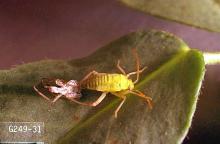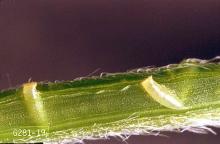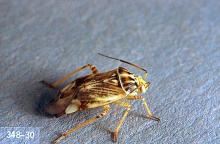Includes
Lygus bug (Lygus spp.)
Brown marmorated stink bug (Halyomorpha halys)
Stink bug (several species)
See also:
Brown Marmorated Stink Bug: An Emerging Threat to Pacific Northwest Agriculture
Pest description and crop damage Lygus bugs are small, semi-oval bugs. Adults are 0.15 to 0.2 inch in length, brown, green, gray, or almost black with a yellow "V" on the back. They may feed on and damage fruit and blossoms. Stink bugs are gray, brown, or green, and are shield-shaped; they are about 0.5 to 0.7 inch in length. These bugs pierce fruit with their mouthparts and siphon out tissue fluids. This feeding damage causes dimpling, sunken spots on young fruit and can deform mature fruit (often referred to as cat-facing). Interior fruit damage appears as white, corky areas. These bugs have an extremely wide host range that includes field and vegetable crops, hay crops, natural vegetation in uncultivated land and weeds in adjacent areas. These pests do not reproduce on tree crops, but invade from outside hosts, or from orchard ground cover.
Biology and life history Adults typically overwinter in groundcover. They feed early in the season on weeds and later may move into fruit tree canopy. Stink bug damage is worse in dry summers when alternative hosts are dried up.
Pest monitoring Periodically scout fruit trees for the presence of adult lygus and stink bugs particularly in trees with a history of bug damage to the fruit. Critical times to scout are when the adjacent weed hosts are drying up or when nearby host crops are being harvested.
Management-cultural and biological control
When possible, do not plant peach or nectarine trees adjacent to hay fields, weedy lots, or uncultivated land. Proper weed management early in the season can reduce the attractiveness of an orchard to these mobile pests. DO NOT mow orchard floor within two weeks prior to fruit harvest as any bug infestation in the ground cover will move to the tree canopy.
Management-chemical control
Spray applications, primarily pyrethroid products, target adult bugs. Spray residue contacts and intercepts lygus and stink bugs as they move between outside host source and fruit tree. Use of the pyrethroid products may result in increased problems with spider mites.
Management-chemical control: HOME USE
- acetamiprid-Stink bug only. Toxic to bees.
- azadirachtin (neem extract)-Some formulations are OMRI-listed for organic use.
- carbaryl-Highly toxic to bees.
- esfenvalerate--Highly toxic to bees.
- gamma-cyhalothrin--Highly toxic to bees.
- kaolin clay-Repels some insect pests when applied as a spray to leaves, stems, and fruit. OMRI-listed for organic use.
- lambda-cyhalothrin-Stink bug only. Highly toxic to bees.
- pyrethrins-Highly toxic to bees. Some formulations are OMRI-listed for organic use.
- zeta-cypermethrin--Highly toxic to bees.
Management-chemical control: COMMERCIAL USE
Dormant and delayed-dormant sprays
- esfenvalerate (Asana XL) at 4.8 to 14.5 fl oz/A. REI 12 hr. Extremely toxic to fish and wildlife; avoid spray drift and runoff to surface waters.
Spring and summer sprays
- esfenvalerate (Asana XL) at 4.8 to 14.5 fl oz/A. REI 12 hr. PHI 14 days. May disrupt beneficial mite populations. Extremely toxic to fish and aquatic invertebrates; avoid spray drift and runoff to surface waters.
- lambda-cyhalothrin (Warrior II) at 1.3 to 2.5 fl oz/A. REI 24 hr. PHI 14 days. May disrupt beneficial mite populations. Extremely toxic to fish; avoid spray drift and runoff to surface waters.




